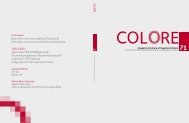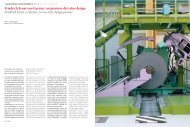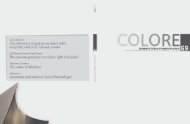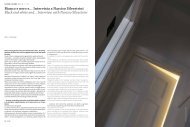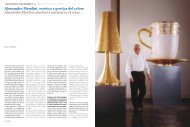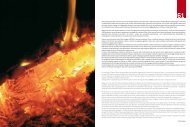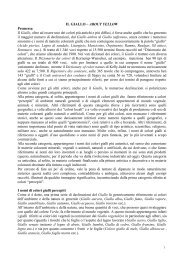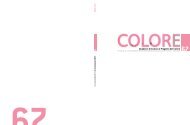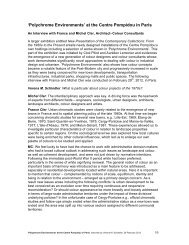Quaderni di Cultura e Progetto del Colore - Istituto Del Colore
Quaderni di Cultura e Progetto del Colore - Istituto Del Colore
Quaderni di Cultura e Progetto del Colore - Istituto Del Colore
You also want an ePaper? Increase the reach of your titles
YUMPU automatically turns print PDFs into web optimized ePapers that Google loves.
CULTURA / CULTURE [ 1 2 3 4 5 6 7 8 (9 + 10) 11 12 13 14 15 16 ]<br />
Figg. 5-6 – Tavolozza dei colori <strong>del</strong>la Liguria e localizzazione<br />
<strong>del</strong>le cave dei materiali lapidei e laterizi e <strong>del</strong>le calci imitati con i<br />
colori citati nei documenti<br />
<strong>del</strong>lo stucco bianco (“Bianco <strong>di</strong> color <strong>di</strong> stucco”, ”Istucco”, “Tinta color<br />
<strong>di</strong> stucco”, “Tinta <strong>di</strong> stucco”, “Tinta <strong>di</strong> stucco chiaro”, “Stucco bianco”,<br />
”<strong>Colore</strong> <strong>di</strong> stucco” ecc.).<br />
Come in Piemonte, infine, abbiamo i colori forniti <strong>di</strong>rettamente dalle<br />
stesse calci (“Bianco”, “Latte <strong>di</strong> calce”, “Latte <strong>di</strong> calce grassa stemperata<br />
a dovere”, “Imbianco”, “Imbianco con latte <strong>di</strong> calce”, ”Imbiancatura”,<br />
”Imbiancamento”, ”Imbianchimento”). A volte, il bianco <strong>del</strong>la “calce<br />
dolce” è accompagnato dal nome specifico <strong>del</strong>la calce locale impiegata<br />
(<strong>di</strong> Cogoleto, <strong>di</strong> Sestri Ponente o <strong>di</strong> Spotorno). Altre volte, il colore giallognolo<br />
è quello tipico <strong>del</strong>la calce idraulica <strong>di</strong> Casale, che lo sviluppo<br />
ferroviario a poco a poco contribuisce a <strong>di</strong>ffondere in tutta l’Italia. <strong>Del</strong>le<br />
altre calci forti citate nei documenti, <strong>di</strong> Borghetto o <strong>di</strong> Oneglia, non è<br />
purtroppo dato <strong>di</strong> sapere quale fosse il colore naturale).<br />
Come in Piemonte, infine, anche in Liguria, a volte i colori vengono definiti<br />
con i pigmenti <strong>di</strong> cui sono composte le tinte a calce o le vernici a olio<br />
(“Terra d’ombra”, “Terra gialla”, “Giallo terra <strong>di</strong> Siena più intenso”, “Nero”,<br />
“Rosso inglese” ecc.).<br />
Siena<br />
Anche a Siena sembrano trovare conferma i criteri “mimetici” <strong>di</strong> colorazione,<br />
riscontrati a Torino e nel Piemonte e a Genova e in Liguria, anche<br />
se in questo caso sono altri i colori che dominano l’immagine <strong>del</strong>la<br />
Città, perché <strong>di</strong>versa è la “geologia applicata” <strong>del</strong> luogo e, non a caso, i<br />
migliori esperti dei colori <strong>di</strong> Siena sono proprio gli specialisti dei materiali<br />
litoi<strong>di</strong> e laterizi locali 9 .<br />
Sul versante dei colori imitativi dei materiali e<strong>di</strong>lizi locali abbiamo, al<br />
solito, le calci declinate variamente (“Calcina”, “Calcina macchiata <strong>di</strong><br />
giallo”, “Calcina naturale”, “Calcina scura”, “<strong>Colore</strong> calce”, “Color <strong>di</strong> calce”<br />
“<strong>Colore</strong> calcina”, “<strong>Colore</strong> calcina naturale”, “Imitazione <strong>di</strong> calce naturale”,<br />
“Imitazione <strong>di</strong> calcina naturale” “<strong>Colore</strong> <strong>del</strong>la calcina invecchiata”,<br />
“Imitazione <strong>del</strong>la vecchia calcina”, “Tinta <strong>di</strong> calcina naturale”).<br />
A Siena, oltre ai nomi <strong>del</strong>le calci, non possono mancare naturalmente i<br />
nomi dei pigmenti ed in particolare le “terre coloranti” <strong>di</strong> cui la Toscana<br />
e la stessa Siena sono ricche (“Terra gialla” e “Terra d’ombra bruciata”),<br />
oltre alla “Terra verde”, al “Verde montagna”, al “Nero fumo” ecc.<br />
Come negli altri casi-stu<strong>di</strong>o esaminati, anche a Siena emergono i colori<br />
dei materiali lapidei locali veri o imitati (“<strong>Colore</strong> pietra arenaria gialla”,<br />
“Pietra gialla”, “<strong>Colore</strong> pietra serena”, “Pietra serena”, “Pietra serena<br />
chiara”, “Pietra serena scura”, “Pietra serena finta scura”, “<strong>Colore</strong> pietra<br />
naturale serena”, “<strong>Colore</strong> <strong>di</strong> pietra serena chiara ad imitazione <strong>del</strong>-<br />
6<br />
besides “Green earth”, “Mountain green”, “Smoke black” etc.<br />
As in the other examined case-histories, in Siena too the colours of local<br />
stone materials, real or imitated, are present (“Yellow sandstone<br />
colour”, “Yellow stone”, “Grey sandstone colour”, “Grey sandstone”,<br />
“Light grey sandstone”, “Dark grey sandstone”, “Dark fake grey sandstone”,<br />
“Natural grey sandstone colour”, “Light grey sandstone colour<br />
imitating the natural one coming from Signa mines”, “Bluish paint imitating<br />
Signa stone”, “Fake grey sandstone”, “Painted fake grey sandstone”,<br />
“Tuff”, “Bright tuff”, “Dark tuff”, “Yellow tuff stone”, “Yellow tuff<br />
stone colour”, “Tuff colour”, “Tuff-like colour”, “Light tuff colour”, “Tuff<br />
stone colour”, “Fake yellow tuff”, “Fake tuff”, “Light tuff imitation”,<br />
“Fake stone”, “Fake tower stone”, “Tower stone imitation”, “Fake old<br />
stone”, “Stone imitation”, “Sandstone imitation”, “Grey sandstone imitation”,<br />
“Sandstone-like grey”, “Lighter sandstone-like grey”. Next to the<br />
colours of stones there is the local travertine, real or imitated, with its<br />
peculiar textures (“Travertine”, “Travertine colour”, “Fake travertine”,<br />
“Stucco detailing that imitates travertine”).<br />
Differently from Turin or Genoa, in Siena, the brick materials colours<br />
are paired with the same frequency to the stone materials ones, that,<br />
as we have seen, are very common (“Brickwork”, “Fake brickwork”,<br />
“Brick”, “Old brick”, “Simulated bricks”, “Fake brick”, “Colouring that imitates<br />
the old brickwork”, “Brickwork imitation”, “Brick rows imitation”,<br />
“Old brick imitation” etc.).<br />
Together with brick, terracotta appears in all its variations (“Terra-cotta”,<br />
“Fake terracotta”, “Terracotta imitation” etc.).<br />
As in Piedmont and in Liguria, also in Siena wooden materials colours<br />
are imitated, being them generic or specific (“Fake timber”, “Cypress<br />
imitation”, “Walnut”, “Walnut imitation”).<br />
Rome<br />
As seen for the cities examined up to now, also the colouring of Rome<br />
seems to follow the same criterions found until now, obviously adapting<br />
them to the peculiar “local geology” 10 .<br />
Among stone materials, in particular, it seems to appear absolutely<br />
dominant the travertine colour in all its possible variations (“Scorched<br />
travertine white”, “Travertine imitating white”, “Travertine imitating<br />
dark white”, “Travertine imitating old white”, “Travertine white”, “Travertine<br />
colour”, “Half-tone travertine colour”, “Travertine colour”, “Halftone<br />
travertine colour”, “Travertine imitating colour”, “Old travertine<br />
5<br />
la naturale <strong>del</strong>la cava <strong>di</strong> Signa”, “Tinta azzurrognola imitante la pietra<br />
<strong>di</strong> Signa”, “Finta pietra serena”, “Finta pietra serena pitturata”, “Tufo”,<br />
“Tufo chiaro”, “Tufo scuro”, “Pietra tufacea gialla”, “<strong>Colore</strong> pietra tufacea<br />
gialla”, “Color tufo”, “<strong>Colore</strong> a tufo”, “Color <strong>di</strong> tufo”, “Color tufo chiaro”,<br />
“Color tufaceo”, “Finta pietra tufacea gialla”, “Finto tufo”, “Imitazione <strong>di</strong><br />
tufo chiaro”, “Finta pietra”, “Finta pietra <strong>di</strong> torre”, “imitante la pietra <strong>di</strong><br />
torre”, “Finta pietra vecchia”, “Imitazione <strong>di</strong> pietra”, “Imitazione <strong>di</strong> pietra<br />
arenaria”, “Imitazione <strong>di</strong> pietra serena”, “Uso pietra serena”, “Uso pietra<br />
serena più chiara”. Al colore <strong>del</strong>le pietre si affianca il colore <strong>del</strong> travertino<br />
locale, vero o imitato con le caratteristiche textures (“Travertino”,<br />
“Color travertino”, “Finto travertino”, “Finitura a stucco a imitazione <strong>di</strong><br />
travertino”).<br />
Diversamente da Torino o da Genova, a Siena, i colori laterizi si affiancano<br />
con pari frequenza rispetto a quelli lapidei, che pure abbiamo visto<br />
molto presenti (“Cortina <strong>di</strong> mattoni”, “Finta cortina”, “Finta cortina<br />
<strong>di</strong> mattoni”, “Mattone”, “Mattone vecchio”, “Mattoni simulati”, “Finto<br />
mattone”, “Coloritura a imitazione <strong>del</strong>la vecchia cortina”, “Imitazione<br />
<strong>di</strong> cortina <strong>di</strong> mattoni”, “Imitazione <strong>di</strong> filaretti <strong>di</strong> mattoni”, “Imitazione <strong>di</strong><br />
mattone vecchio” ecc.).<br />
Accanto al mattone, appare la terracotta in tutte le sue declinazioni<br />
(“Terra cotta”, “Finta terra cotta”, “Imitazione <strong>di</strong> terra cotta” ecc.).<br />
Come in Piemonte e in Liguria, anche a Siena si imitano infine i colori dei<br />
materiali lignei , sia generici che specifici (“Finto legname”, “Imitazione<br />
cipresso”, “Noce”, “Imitazione noce”).<br />
Roma<br />
Come si è visto per le altre città finora esaminate, anche la colorazione<br />
<strong>di</strong> Roma sembra seguire gli stessi criteri finora riscontrati, adattandoli<br />
ovviamente alla particolare “geologia locale” 10 .<br />
Tra i materiali lapidei, in particolare, si vede emergere in modo assolutamente<br />
dominante il colore travertino con tutte le sue declinazioni<br />
possibili (“Bianco <strong>di</strong> trevertino cotto”, “Bianco imitante il travertino”,<br />
“Bianco scuro imitante il travertino”, “Bianco vecchio imitante il travertino”,<br />
“Bianco travertino”, “Color travertino”, “Color travertino mezza tinta”,<br />
“Color travertino” , “Color travertino mezza tinta”, “<strong>Colore</strong> imitante il<br />
travertino”, “Grigio imitante il vecchio travertino”, “Mezzatinta a imitazione<br />
<strong>del</strong>la vecchia pietra travertino”, “Mezzatinta a travertino”, “Mezza<br />
tinta color <strong>di</strong> travertino”, “Mezzatinta colore travertino abbassato”,<br />
“Tinta grigia imitante il travertino”, “Tinta imitante il vecchio travertino”,<br />
“Travertino”, “Travertino [Finto]”, “Travertino [Imitante il colore <strong>del</strong>]”,<br />
Colori <strong>del</strong>le città italiane / Colour of italian cities<br />
imitating grey”, “Half-tone imitating the old travertine stone”, “Travertine<br />
half-tone”, “Travertine coloured half-tone”, “Darkened travertine<br />
coloured half-tone”, “Grey imitating travertine hue ”, “Old travertine<br />
imitating hue”, “Travertine”, “ [Fake] Travertine”, “Travertine [Imitation<br />
of]”, “Old style travertine”, “Darkened travertine”, “Just half tone lighter<br />
travertine”, “Coated travertine”, “Much lighter coated travertine”, “Old<br />
mated travertine”, “Half tone travertine”, “Darker half-tone travertine”,<br />
“Washed travertine”, “Lighter travertine”, “Dark travertine”, “Old-like<br />
travertine”, “Old travertine”, “Old travertine [Imitating colour]”, “Old<br />
dark travertine” etc.).<br />
As seen also for the terms that often are related to travertine colour<br />
(“old”, “dark old”, “coated”, ”darkened”, “dark”, etc.), it is clear that in<br />
many cases there is an intention of integrating the “mating” hue to the<br />
existing colours, in a context that, for example, involves repainting a<br />
boundary wall or even a secondary wall where masonry works have<br />
been carried on, when it is not the case of mere touch ups or patches,<br />
maybe on the very same travertine, for which there is no trouble painting<br />
it in order to maintain it or to preserve the aesthetics of the facade.<br />
Next to travertine, there are marble colours, either generic (“Marble<br />
colour”) or white (“White marble colour”) and in this case too, it is often<br />
possible to find this colour laid on a real marble sculpture, put onto a<br />
wall or even stan<strong>di</strong>ng isolated in a garden, as it was possible to read in<br />
the archive documents regar<strong>di</strong>ng the restoration of Villa Me<strong>di</strong>ci..<br />
When marbles or the colours that imitate them are specific, they are<br />
often laid on decorative details and not on whole facades, as in the case<br />
of “Cipollino” (light green veined marble), “White veined marble” etc.<br />
Among stones, there is tuff, also in this case with its many variations<br />
in order to match existing colourings (“Ancient tuff colour [composed<br />
by umber]”, “Tuff stone”, “Dark tuff“, “Old tuff imitating colour“ and peperine<br />
(“Peperino”, “So called peperino stone” etc.).<br />
Among brick materials, the often occurring characteristic Roman brick<br />
dominates, most often in boundary walls (“Wall colour”, “Light walls<br />
colour” , “Brick wall colour”, “Brick colour”, “Walls half-tone colour”,<br />
“Brick colour”, “Wall colour imitating old brick”, “Light rose brick colour”,<br />
“Light red brick colour”, “Coated wall colour”, “Walls colour”, “Dark brick<br />
colour”, “Half-tone wall colour”, “Brick”, “Old brick [Imitating colour]”.<br />
Even in this case, it is clear the intention concerning the integration<br />
with the existing context (“Old brick [Imitating colour]”, “Coated wall<br />
colour”, when it is not a case of mere patching up or completing exist-<br />
40 COLORE<br />
COLORE 41



